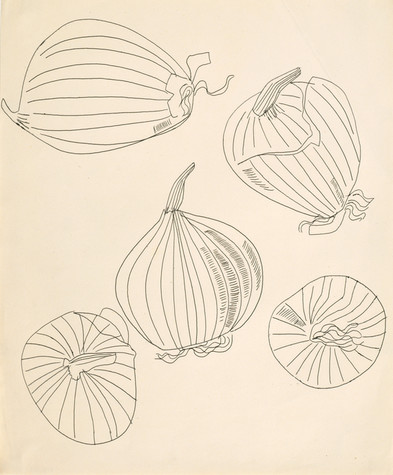The following assessments can be used for this lesson using the downloadable assessment rubric.
- Aesthetics 1
- Aesthetics 3
- Creative process 3
- Creative process 5

Andy Warhol, Five Views of an Onion, 1950s
The Andy Warhol Museum, Pittsburgh; Founding Collection, Contribution The Andy Warhol Foundation for the Visual Arts, Inc.
© The Andy Warhol Foundation for the Visual Arts, Inc.
1998.1.1750
Although Warhol is best known for his silkscreen prints, he was also an excellent draughtsman. Drawing was a constant part of his artistic practice. As a child he took art classes at the Carnegie Museum of Art and later won awards for drawings he had made in high school. At Carnegie Institute for Technology (now Carnegie Mellon University, which Warhol graduated from with a degree in pictorial design), Warhol’s offbeat, nontraditional drawing style did not meet all his professors’ academic standards, and he was forced to do extra work in this area over summer break. In the 1950s, Warhol’s blotted line drawing technique defined his signature style for his commercial work. He also filled sketchbooks with freehand drawings, mostly done in ballpoint pen, of friends and still lifes. Several of his whimsical sketches and drawings from this era were published in magazines and books, such as The Best in Children’s Books series and a little-known vintage cookbook called Wild Raspberries. Other sketchbook drawings were exhibited as fine art, such as Studies for a Boy Book, displayed at the Bodley gallery in New York in 1956. In his pop artwork, Warhol used a combination of mechanical and hand-drawn techniques as well as an opaque projector to trace outlines of images in preparation for his paintings. He also incorporated drawn lines in his later silkscreened images, such as Mao Wallpaper, Mick Jagger, Gems, and his 1980s commercial work.
I was doing my [drawing] technique and then they told me I had to go to summer school, and if I didn’t go to summer school I couldn’t come back, so then I went to summer school and learned how to draw like they did.
One Sunday…we went down to the flower market and bought some irises and came back and spent the afternoon drawing…He would just draw one line and then leave it, and when I would draw things, I was always erasing, changing, and improving. And he never improved on anything. Rather than do that, he would draw a new one, which is something I never thought of doing in those days.
Charles Lisanby in Patrick Smith, Andy Warhol’s Art and Films, 1988
Students self assess their work and the work of their peers by using a rating scale from 1 to 5. 1=unacceptable; 2=needs work; 3=mediocre; 4=well done; 5=outstanding. Students group the drawings according to each rating. As a class, discuss the criteria the students used to make their choices.
The following assessments can be used for this lesson using the downloadable assessment rubric.